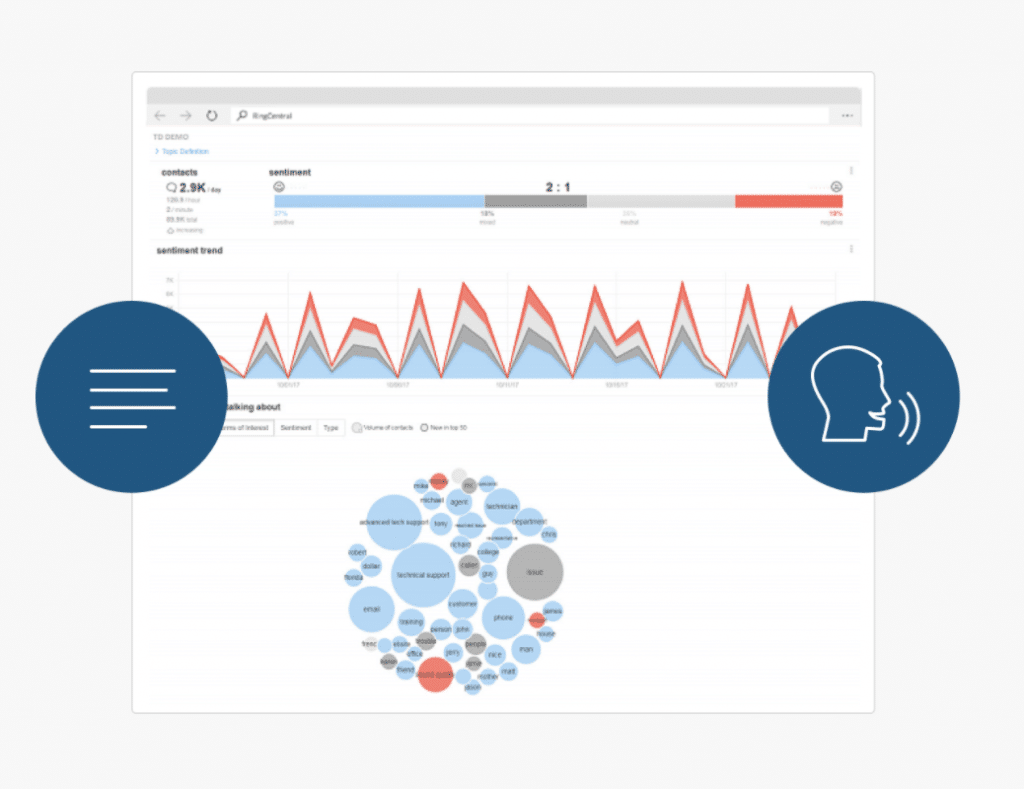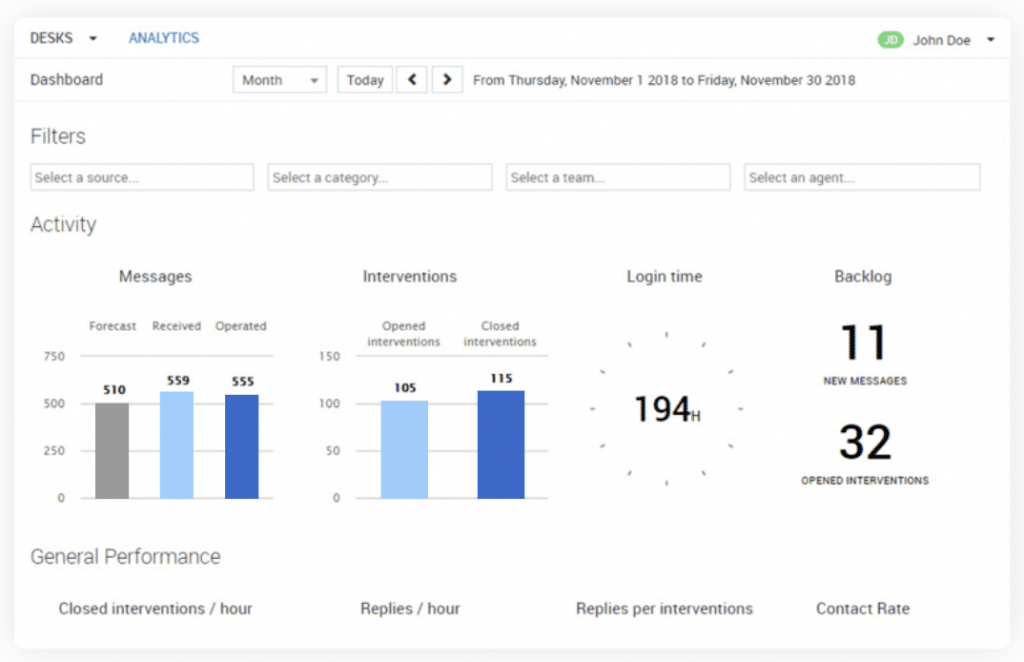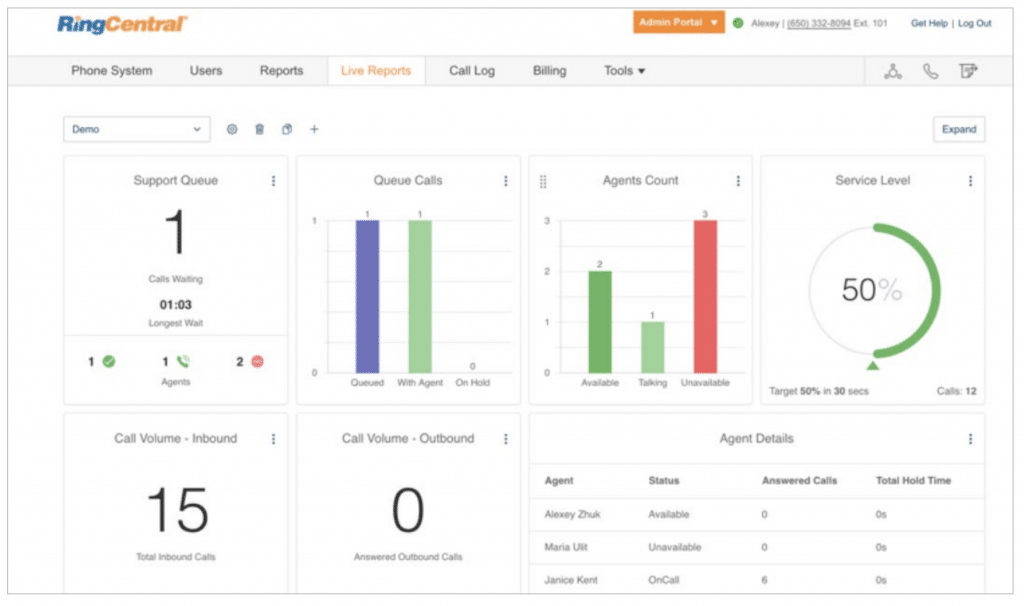It can be tricky deciding how to measure customer service quality at your small business. There are so many different approaches, so many different customer service measurements… Where should you start?
One reliable way to start measuring customer service performance is by using KPIs, or key performance indicators. If this isn’t a term you’ve heard before, or even if you need a refresher in customer support KPIs, we’ll get you up to speed.
In this post, we’ll cover:
- What customer service KPIs are
- “Customer service KPIs” vs “customer analytics”
- Best practices for tracking and measuring customer service KPIs
- 8 customer service KPIs to track
⭐️⭐️⭐️⭐️⭐️ Ready to offer 5-star customer service? Get strategies for every stage of the customer journey with this free eBook.
What are customer service KPIs?
As Maria Von Trapp would say, “Let’s start at the very beginning,” with how KPIs are defined in general.
Key performance indicators, or KPIs, are the measurements used to indicate how well your team is doing in relation to their set goals. “Performance” here isn’t just about quality or speed of work; it’s specifically tied to the pursuit of a goal.
With this definition, you can probably see that customer service KPIs (or customer engagement KPIs) are the measurements used to show if your service team’s performance is helping the business be successful and reach its goals.
[ebook-download title=”How customer-obsessed is your business?” link=”https://netstorage.ringcentral.com/documents/quiz_how_customer_obsessed_your_business.pdf” cta-text=”Take the quiz” src=””]
“Customer service KPIs” vs “customer analytics”
Maybe you’ve heard the term customer service KPI used interchangeably with customer analytics, or even customer metrics. Before we get any deeper into this post, let’s clear up any potential confusion:
- Customer metrics are objective data about customer interactions, generated by any number of processes.
- Customer experience analytics are the interpretation of trends in these metrics, most often used to create projections and predictions.
- Customer service KPIs also use those metrics, but to track performance on set goals related to customer service.
To put it even more simply, both analytics and KPIs use metrics, but in different ways: one to make predictions, and the other to specifically track goal performance.
Customer service KPIs: best practices
Now that we have the semantics cleared up, let’s get into the reason you’re really here: to learn how to use KPIs for customer service—and do it well.
For starters, here are some customer service best practices when it comes to measuring KPIs that will serve you well, no matter what your goals are:
Adopt the KPIs that are right for your small business
KPIs aren’t one-size-fits all. Just because other companies or industries are using a certain set of KPIs for their customer service team doesn’t mean you need to, too.
Ignore the peer pressure. Think about what success looks like for your specific business as you plan your KPIs, and implement what makes the most sense for you and your team.
Set realistic goals
Ambition is a beautiful thing. But sometimes, shooting for the moon ends up feeling more like shooting yourself in the foot. Set goals that seem within reasonable reach of your customer service team so they aren’t constantly chasing the finish line and falling short. A goal should be a challenge, but not an unwinnable one.
How can you figure out the right level of ambition for your goals? If this is your first year measuring customer service KPIs, be conservative; this is a time for creating your benchmarks. You could even forego formal KPIs for the first half of the year as you take and analyze some base-level metrics, then set your KPIs for the latter half of the year and measure against the benchmarks as you plan for the year to come.
Clearly communicate your KPIs… then do it again
Does your customer service department know what their goals and KPIs are for the quarter or year? Upfront and ongoing communication about your objectives and how you measure them is the best way to keep your team informed and working toward a common goal.
Balance KPIs with your other goals
Customer service KPIs are important, but they aren’t everything. There are so many plates spinning in the air when you’re a small business owner—if you’re only focused on the customer service plate, your other departments could suffer.
The easiest way to ensure you’re thinking of everything, and not doubling people’s work, is to directly align your KPI’s with your strategic goals for the year, and do the same with every team’s goals. That way everyone is on the same page, and everyone’s goals and performance indicators relate back to the business’s overall objectives.
Use reliable data to build (and monitor) your KPIs
If your goals aren’t data driven, that’s a recipe for measuring the wrong performance indicators and falling short of the target. When building out your customer service KPIs, make sure you’re relying on historical metrics and input from your customer support team so the next year’s objectives reflect the reality of your business and what you can reasonably work to achieve in the next 12 months.
Your KPIs aren’t set in stone, only to be addressed annually. They should be living, breathing measurements that you can adjust when the need arises throughout the year. Maybe it becomes clear that the way you’re tracking one KPI isn’t taking all factors into account, or maybe it’s not serving your objectives at all. Don’t be afraid to pull your team together during the year to make your KPIs more meaningful.
Automate reporting for customer service KPIs
The best way to stay on top of your team’s performance is to find a tool that does the work for you. Customer service software like RingCentral’s Contact Center come with easy-to-read-and-customize performance dashboards, where you can track your numbers (like call center metrics) and receive email alerts about the most important reports:
And these aren’t just static dashboards. With RingCentral Live Reports, you’ll see trends across your team and be able to drill down to analyze queues, user performance, and call flows with visual call maps.
Review your KPIs on a regular basis
Don’t just set it and forget it! When you establish your customer service KPIs for the year, schedule out biweekly or monthly meetings to go over your dashboards and measure progress.
Reward and support your customer service team
KPIs are a great way to keep track of who stands out and who needs some additional training or encouragement. Using key performance indicators to reward good customer service teamwork and follow up with team members who need assistance reinforces the importance of these indicators to the whole team and can improve the overall employee experience for them. And that might just pay off in higher employee retention rates and better customer service all around.
8 customer service KPIs to track
Here is a rundown of the top customer service KPIs that most businesses track. Remember: this isn’t a “collect the whole set” contest! Be sure to set meaningful, achievable goals for these indicators that tie directly to your team’s performance and what matters most to your business.
1. Customer satisfaction (CSAT)
What it is: This one’s pretty straightforward. Customer satisfaction is the level at which your customers are happy with the products and services you provide.
Why it matters: If you want to grow (and who doesn’t?), customer satisfaction should be a cornerstone of your metrics. For a small business, customer satisfaction is crucial. Happy customers lead to steadier revenue and more reliable referrals.
How to track your customer satisfaction score as a KPI: There are lots of ways to measure how satisfied your customers are, but here are two automated ways to do it that save time and money:
- End-of-interaction surveys: After each call or messaging conversation, send a quick, one-question survey to the customer (“How satisfied are you with your experience today?”). Some contact center platforms like RingCentral include ways to automate customer service and automatically send these customer surveys and build reports, so you can easily track this important metric.
- Track customer sentiment: A contact center tool that’s worth its salt today will include the ability to measure customer sentiment through text speech analytics. This allows you to spot customer trends, issues, and changes quickly by reviewing customer conversations for key topics and phrases. This cool new feature comes standard with RingCentral’s customer engagement solutions:

Use the data you gather from these surveys and sentiments to decide on a reasonable, achievable improvement to your customer satisfaction numbers that your team can work toward over the next year.
If you’re planning to measure your customer satisfaction rate via an end-of-interaction survey, be sure to ask the same exact question year over year, so you know the data is controlled.
Net Promoter Score
What it is: Your Net Promoter Score (NPS) sounds complicated, but it’s simply how likely customers are to recommend (or promote) you to the people in their lives. If you’ve ever filled out a survey that asked “how likely are you to recommend us?”, you’ve helped a company determine their own NPS.
Why it matters: Word of mouth is critical to any business, since people trust their friends’ and fellow consumers’ opinions more than they trust advertisements. This goes double for small businesses who have to work hard for every new fan. Your Net Promoter Score should show you if you’re on the right track to turning customers into ambassadors singing your praises.
How to track your Net P Score as a KPI:
- Much like customer satisfaction, NPS is usually best measured directly following an interaction with your company, when the customers’ feelings about it are still fresh. Send a one-question survey asking how likely the customer is to recommend you to their friends and colleagues.
- Analyze the data from a specific period of time, maybe four to six months, to get a good swatch of your buyers’ input. Find your average Net Promoter Score by adding all of the ratings together and dividing by the number of customers surveyed. (Hint: some customer engagement solutions like RingCentral calculate your NPS for you!)
- Use this data to set a reasonable, achievable goal for your team to work toward for the next year.
3. Customer retention rate
What it is: Your customer retention rate is the average length of time that someone stays your customer.
Why it matters: Loyal customers are the lifeblood of small businesses. They do consistent business with you and sing your praises to their friends and family. Plus, it’s a lot cheaper to keep a customer than woo a new one. That’s why customer retention metrics are an important one to track, no matter what industry you’re in.
How to track your customer retention rate as a KPI:
- Find out how many customers you have at the end of a given period (week, month, or quarter).
- Subtract the number of new customers you’ve acquired over that time.
- Divide by the number of customers you had at the beginning of that period.
- Then, multiply the result by one hundred for your percentage.
- If possible, do this same equation for the prior year; by how much did this number improve, or slip?
- Use this historical data to determine a reasonable year-over-year goal to set as a KPI.
[(# of customers at the end of a given period – # of customers acquired over that time) / # of customers at the beginning of the period] x 100 = customer retention rate
Wondering if you have a good retention rate?
Read more: How to Calculate and Improve Your Customer Retention Rate
4. First call resolution (FCR) rate
What it is: Your first call resolution rate (or first contact resolution rate) shows the amount of customers you’re able to help within their first interaction, whether it’s on the phone or via email, social media, or other contact.
For example, someone calls you because a product they bought from you just broke. Your team is able to get a replacement sent out that day. Problem: solved, in one phone call alone.
Why it matters: Put yourself in your customer’s shoes. How great is it when all it takes is one phone call? That’s why racking and improving your first call resolution rate can make a big impact on customer satisfaction and retention.
How to use first call resolution as a KPI:
- Use your contact center analytics portal to find out how many customer requests were resolved in a single interaction at the end of a given period (month, quarter, or year).
- Divide by the number of requests you received during that period.
- Then, multiply the result by 100 for your percentage:(# of customer requests resolved in a single interaction in a given period / # of requests) x 100 = FCR rate
- If you have the historical data, see how your FCR has improved or slipped over time. Use this data to determine a reasonable goal your team can work toward over the next year.
See how your FCR rate stacks up
Read “First Call Resolution Standard: Impress Your Callers in Minutes”
5. Unresolved issues
What it is: This KPI is about the number of active or open issues your service team has in your customer contact system at any given moment.
Why it matters: Tracking active issues can be one way to tell if your support team (especially important if it’s a remote support team) has the resources and knowledge they need to best assist customers who reach out. If there are dozens of open, unresolved issues in the queue, it’s likely your folks are overwhelmed and in need of rescue, in the form of more training or potentially more hands on deck. This number is probably more important for businesses in industries that offer urgent assistance, like healthcare and insurance. But any business probably wants to improve at closing issues as quickly (and effectively) as possible.
How to track unresolved issues as a KPI:
Lean on your contact center metrics to find the average number of unresolved issues in the queue each day, week, or month. Look back on historical data; has this number increased from last year at the same time period? If so, this might be a good KPI to tie to your goals.
RingCentral’s customer engagement platform tracks your team’s activity across channels and gets a full picture of their performance so you can optimize strategy and improve KPIs, like the number of open issues there are and how many your team has closed in a given period of time:

Use the current and historical data to set a reasonable bar: maybe it’s five open issues, or 15. We won’t give you a number, since every small business is so different. The goal might be per agent or for the entire team during the day or week. Whatever you decide, make it a clear goal that everyone can help to monitor.
6. Average response time
What it is: How long does it take for a customer to have their issue solved? That’s your average response time, or ART.
Why it matters: People feel cared for when you make their question or concern a priority. The ability to resolve more customer outreach more quickly can really improve your patrons’ feelings about your business. And in the experience economy, that’s the dream.
How to use ART as a KPI: Again, you’ll need the right tools for the job. A great customer engagement platform can help you easily find and track your team’s average response time over any given period of time.
If quick turnaround is important to you and your customers, this might be a perfect KPI to align to your business goals for the year. Use the data you gather to decide a reasonable reduced ART that you want to shoot for. Emphasize this number with your team, as they hold the key to success in their interactions, and update them on progress regularly to encourage them to keep up the good work.
7. Escalation rate
What it is: The escalation rate is the percentage of customers who end up asking to speak to a manager during their interactions with your first-line customer service team. The lower this rate is, the better, because it frees up your managers to deal with only the most complex and high-priority customer requests.
Why it matters: Your escalation rate is a good indicator of how well trained and courteous your service team is. If your customers are routinely getting frustrated and asking to speak to a manager, that usually means they feel like they’ve hit a brick wall with your agents.
A high escalation rate could also signal trouble in sales; it could mean that there’s a real problem with a product or service you’re offering, if lots of folks are calling demanding exchanges or returns that only a manager can authorize.
How to use escalation rate as a KPI: If you aren’t already tracking how many calls get escalated to supervisors, start now! Create a custom field in your CRM that your team can check off whenever a call escalates above them.
In six months’ time, measure that field against your total calls, and you’ll have a well-informed percentage point to use to set benchmarks and future goals. RingCentral’s customer engagement platform integrates seamlessly with dozens of popular CRMs like Salesforce, Hubspot, Zoho, and more, so you’ll have all of your KPI tracking in one place.
Like most of these other KPIs, it’s best to use your own data to determine what your reduced escalation rate should be for the coming year, especially as you’re starting out. Industry standards are great, but don’t be discouraged if you have a ways to go. Try to beat your own personal best and set goals that are within reach.
8. Employee satisfaction
What it is: We’re sure you know about employee satisfaction, but we can bet you didn’t expect to see it on this list!
Employee satisfaction is the degree to which your team is happy to work for you.
Why it matters: Think back on your own job history. When did you do your best work? Was it when you took pride in the place where you worked, or when you had to drag yourself kicking and screaming to the office?
Happy employees are likely to be more engaged, more proactive, and more pleasant to speak with as a customer. It stands to reason that happier employees will lead to happier customers, and happy customers—and employees—stick around.
How to use employee satisfaction as a KPI: The easiest way to measure employee satisfaction is with an employee engagement survey. Keep it anonymous, so people feel comfortable telling the truth, even if it’s hard to hear. Let your team know how you will use the results, too, so they know their voice makes a difference.
An employee satisfaction survey can be as simple as one question: “How happy are you to come to work?” or “How satisfied are you with working here?” Or, if you want to do more than just take the temperature, you can do a more formal, long-form survey to gather information on areas in your culture that are in need of improvement.
Whatever style survey you choose, be sure to keep at least one direct question about employee satisfaction the same every time, so you can monitor a change in the results over time and set reasonable goals to measure against.
Customer service KPIs: rally your team
Clear communication is critical to any business, especially when it comes to your goals. Key performance indicators are a powerful way to rally your customer service team around a common finish line, measure meaningful success, and boost morale.
So now, it’s time to reflect: what pieces of customer service are the most important indicators of success to you and your business? Which of the KPIs above, if given focus and energy for a year, could really improve customer experience and retention? Pull a team together, look at metrics, and decide which KPIs to bake into your next strategic plan.
Originally published Apr 16, 2020, updated Jun 19, 2024





